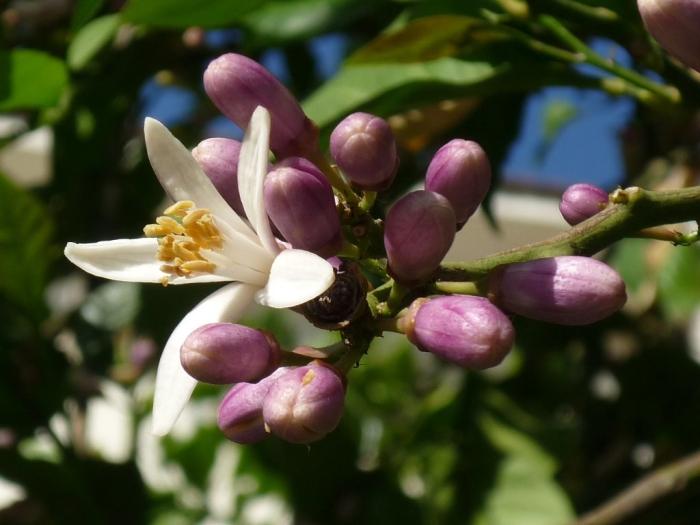Lemon
(Citrus ×limon)
Lemon (Citrus ×limon)
/
/

Jesús Cabrera
CC BY 2.0
Image By:
Jesús Cabrera
Recorded By:
Copyright:
CC BY 2.0
Copyright Notice:
Photo by: Jesús Cabrera | License Type: CC BY 2.0 | License URL: https://creativecommons.org/licenses/by/2.0/ | Uploader: jccsvq | Publisher: Flickr |


















































Estimated Native Range
Summary
Citrus ×limon, commonly known as Lemon, is an evergreen tree or shrub that originated from the artificial cross of Citrus medica (citron) and Citrus aurantium (bitter orange). It is not naturally occurring in the wild but has been widely cultivated in Mediterranean climates, as well as in subtropical and tropical regions around the world. Lemon trees typically reach a height of 10 to 20 feet (3 to 6 meters) with a similar spread, and they have a rounded canopy with dense foliage. The leaves are glossy and green, providing year-round interest. The fragrant flowers are white with a purple base and appear throughout the year, with the main flush in spring. Lemons are highly valued for their bright yellow fruit, which is both ornamental and edible, with a peak fruiting season in winter to early spring.
Lemon trees are popular in home gardens and commercial orchards for their fruit, which is used for culinary and non-culinary purposes. They are also planted as ornamental trees in landscapes and containers. Lemons require full sun and well-drained soil to thrive, and they benefit from regular watering and fertilization. While they are relatively easy to maintain, they can be susceptible to pests such as aphids, scale insects, and citrus leaf miners, as well as diseases like citrus canker and root rot. To prevent these issues, good cultural practices and occasional treatments may be necessary. In areas with cold winters, lemons can be grown in pots and brought indoors to protect them from frost.CC BY-SA 4.0
Lemon trees are popular in home gardens and commercial orchards for their fruit, which is used for culinary and non-culinary purposes. They are also planted as ornamental trees in landscapes and containers. Lemons require full sun and well-drained soil to thrive, and they benefit from regular watering and fertilization. While they are relatively easy to maintain, they can be susceptible to pests such as aphids, scale insects, and citrus leaf miners, as well as diseases like citrus canker and root rot. To prevent these issues, good cultural practices and occasional treatments may be necessary. In areas with cold winters, lemons can be grown in pots and brought indoors to protect them from frost.CC BY-SA 4.0
Plant Description
- Plant Type: Tree
- Height: 4-6 feet
- Width: 3-4 feet
- Growth Rate: Moderate
- Flower Color: White
- Flowering Season: Spring, Summer, Fall, Winter
- Leaf Retention: Evergreen
Growth Requirements
- Sun: Full Sun
- Water: Medium
- Drainage: Fast, Medium
Common Uses
Bee Garden, Bird Garden, Butterfly Garden, Deer Resistant, Edible*Disclaimer: Easyscape's listed plant edibility is for informational use. Always verify the safety and proper identification of any plant before consumption., Fragrant, Hedges, Hummingbird Garden, Low Maintenance, Potted Plant, Salt Tolerant
Natural Habitat
Widely cultivated in Mediterranean, subtropical, and tropical regions
Other Names
Common Names:
Scientific Names: Citrus ×limon , Citrus ×bergamia , Citrus ×meyeri , Citrus lemon , Citrus limonia , Citrus ×limonum , Citrus ×aurantium subsp. bergamia , Citrus medica var. limon , Citrus medica subsp. limonum , Citrus aurantium var. bergamia
GBIF Accepted Name: Citrus ×limon (L.) Burm.fil.